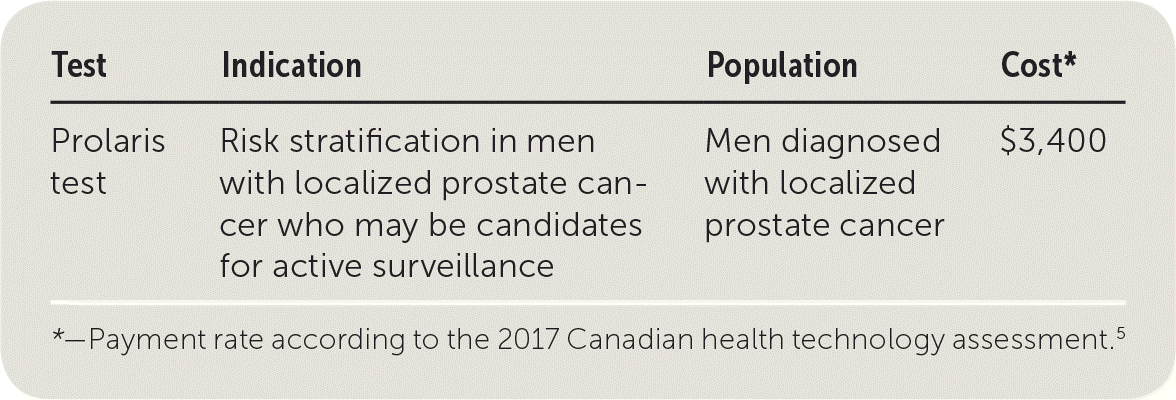
Am Fam Physician. 2019;100(5):311-312
Author disclosure: No relevant financial affiliations.
Prolaris is a genomic test that analyzes changes in 46 genes in prostate biopsy tissue. It generates a risk score to help predict the likelihood of disease progression in men with localized prostate cancer. Prolaris is intended to guide the decision regarding active surveillance without surgery or radiation for low- or intermediate-grade cancers vs. active treatment with immediate surgery or radiation therapy. The National Comprehensive Cancer Network guidelines recommend that physicians consider this test for patients with low-risk and favorable intermediate-risk disease and at least a 10-year life expectancy.1
Accuracy
The risk of prostate cancer progression is currently evaluated based on the prostate-specific antigen (PSA) value, the Gleason score, and clinical factors. Examples of prediction models include the National Comprehensive Cancer Network risk group and a model that integrates clinical, PSA value, and biopsy data.2–4
Prolaris is intended to increase the accuracy of these risk models by adding genetic information, and it provides an estimate of prostate cancer–specific mortality risk and whether the patient's cancer is less aggressive, similarly aggressive, or more aggressive than other patients in the risk group based only on clinical factors.5 The genetic information alone is used to generate a 10-point score, although the final risk assessment incorporates clinical factors as well as the genetic information. After adjusting for clinical characteristics such as PSA value, Gleason score, age, and the extent of spread, every additional point in the 10-point score is associated with a doubling in the risk of disease progression, indicating that the genetic information provides additional risk stratification beyond the clinical factors alone.

| Test | Indication | Population | Cost* |
|---|---|---|---|
| Prolaris test | Risk stratification in men with localized prostate cancer who may be candidates for active surveillance | Men diagnosed with localized prostate cancer | $3,400 |
Benefit
The potential clinical benefit of Prolaris is that men could make a more informed, personalized decision regarding active surveillance vs. active treatment for localized prostate cancer. This is especially relevant for patients with a low or intermediate risk of disease progression based on clinical factors as calculated by one of the risk scores mentioned earlier. There have been no randomized trials or even modeling studies comparing patient-oriented outcomes such as morbidity or mortality when care is guided vs. not guided by Prolaris. To date, all studies have been industry sponsored.
Two U.S. cohort studies have reported changes in treatment decisions based on Prolaris results. The first study included 305 patients; the mean age was 67 years, the mean PSA value was 7.7, 52% of patients had a Gleason score of 6 or less, 40% had a Gleason score of 7, and 8% had a Gleason score of 8 or more.6 After receiving Prolaris test results, 24.4% of low-risk patients, 16.8% of intermediate-risk patients, and 15.4% of high-risk patients said they would change their planned treatment from interventional (e.g., surgery, radiation, androgen deprivation) to an active surveillance strategy. Conversely, 7.4% of low-risk patients, 12.2% of intermediate-risk patients, and 17.9% of high-risk patients changed their planned treatment from noninterventional to interventional.
The second study included 1,206 patients; the mean age was 66 years, and the mean PSA value was 7.8. Of these patients, 48% had a Gleason score of 6, 40% had a score of 7, and 12% had a score of 8 or more. This study differed from the first in looking at actual treatment decisions rather than professed decisions only. The initial treatment plan before Prolaris testing was compared with the actual treatment received after the test was performed.7 Of 417 patients initially choosing noninterventional therapy, 101 (24.2%) changed to interventional therapy. Of 789 patients initially choosing interventional therapy, 112 (14.2%) changed to noninterventional therapy. Neither study showed evidence that the use of Prolaris improves patient-oriented outcomes, either directly from randomized trials or indirectly from modeling studies.
Harms
Harms of Prolaris have not been studied. Potential harms include additional stress, decisional conflict or regret, and a change in treatment strategy resulting in a worse outcome in terms of morbidity or mortality.
Cost
A 2017 Canadian health technology assessment estimated that the cost of Prolaris was $3,400 based on published literature.5 The same health technology assessment performed a cost-effectiveness analysis and estimated that over five years, widespread adoption of this test in Ontario would result in $48.6 million in additional costs, primarily because of the high cost of the test itself, compared with a cost savings of only $7.3 million as a result of changes in treatment based on Prolaris results.5
Bottom Line
The Prolaris test improves the accuracy of prognosis for patients with prostate cancer, especially those with low- or intermediate-grade disease who may be deciding between interventional and noninterventional treatment approaches. However, it is premature to recommend use of this test outside of the research setting, given the high cost and lack of evidence that it improves patient-oriented outcomes.
Editor's Note: Dr. Ebell is Deputy Editor for Evidence-Based Medicine for AFP.
